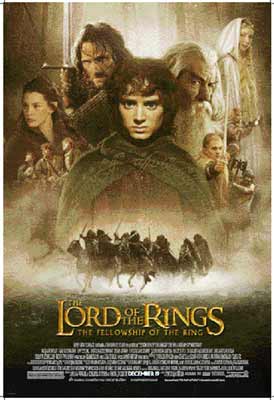

When the “Lord of the Rings: Fellowship of the Ring” premiéred on 19 December, 2001, sword fans around the World were thrilled to see the amount of work that had gone into the design and making of the swords and other weapons. In this exclusive interview, we’ll hear some behind-the-scenes comments from two of the men responsible for the way the swords turned out: fantasy artist and conceptual designer John Howe and sword-smith Peter Lyon.
A note on the interview: While I’m fully aware that the swords and other props were the result of a team effort, I choose to interview the two men who had, in my eyes, made the swords the best in the history of fantasy movies. Other designers who were heavily involved in the design of the swords were Daniel Falconer, Warren Mahy and Ben Wooton. Their work was vital to the success of the designs, so their contribution shouldn’t be forgotten.
Björn: Can you tell us a little bit about yourself and your background?
|
|
|
|
Peter: As well as making swords, much of my life is built around my interest in medieval European history, and attempting to recreate and experience various aspects of it. Since I was a child I've had an interest in history, initially in ancient history and its unsolved mysteries, later centring on medieval history. At university in the early 1980's I got into fantasy role-playing games, which I still play today; the combination of pseudo-history combined with magic and fantasy sparked my interest in medieval history in particular, and I became interested in learning to use the weapons of the period and experience combat - though not the messy bits! My involvement in medieval re-enactment started in 1984 and continues today; I started with an interest in combat, which has spread into recreating period combat as well as we safely can, and into making and testing medieval equipment in the field. More recently I have become involved in the equestrian side of medieval re-enactment, and I have been jousting for the last two years. It is a demanding and challenging sport, but very satisfying. Like the other parts of my hobbies, it has helped at times in the making of props for the film, because I have an appreciation of how the props need to work, and how I would like them to work if I had to use them myself.
John: I spent a few years in art school, like most kids who aren't fit to get a proper job. Otherwise, I’m just illustrating freelance. We also have a little re-enactment group. Check out www.companie-of-st-george.ch.
B: Peter, for how long have you made swords and how did you come to be involved in the "Lord of the Rings"?
P: I made my first sword for myself, as I couldn't afford to buy one, in 1986. I gradually built up my metalworking skills, and people started asking me to make weapons and armour for them. I continued part time until 1993, when I had built up a reasonable workshop and felt ready to make the leap into self-employment. It was difficult for the next couple of years, but slowly it was turning into a reasonable living, then Richard Taylor of Weta Workshop contacted me. I had known Richard for several years, keeping in touch in case the possibility of work in a film or TV production came up. He called me in to the workshop at the end of 1997 to talk about a project that was in the early stages of pre-production. It was so secret at the time he couldn't even tell me the name of the production! I only found out the details several months later when I signed on for it, and the rest is history. Starting at the highest level of film-making has been a steep learning curve, but Richard has been great at easing me and others into it.
B: What was your initial reaction when you were asked if you wanted to work with the project, and did you expect the movie project to become that big?
P: To be honest, my first reaction was "Great! Steady work, and on a feature film too". I had been interested in film for a long time, from a technical viewpoint, but had never worked on one before, so I had no real idea what I was getting into. Others involved in shaping the look of the film had already been working on it for months, and it only dawned on me slowly how big a deal this was. As the publicity and interest has grown over time, I've come to realise how important this to so many people, but I still have to pinch myself occasionally to be sure this isn't just a dream!
J: I thought ”Great! Hollywood here we come”. Then I realised it was in New Zealand. Of course it did mean summer for winter, which was lovely.
B: All things considered, that was probably for the better. Every report on the making on the film says it was demanding but fun. Have you worked for the movie industry before?
J: Never. It was very demanding, but enormous fun.
B: John, which weapons did you design?
J: I had a hand in quite a few. It's hard to be specific. Narsil, some of the Nazgûl blades, the Moria orc weapons and armour. Most of other weapons were collective efforts. Here's a good example - I can't for the life of me remember who came up with the spike on the Uruk falchions. It could have been any one of us. It's a silly idea, really, but it symbolises a basic shortcoming in Saruman's preparations, rather like something so specialised it neglects all other eventualities. It also has the merit of pre-defining the fighting style. There was an enormous amount of trading off - an idea would emerge from someone's sketch and others would take that and elaborate further. Peter Jackson's nod was the sign for mad development of any element that appealed to him. Emulation was predominant.
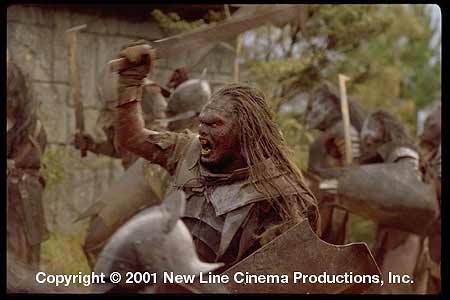
Saruman’s Uruk-hai brandishing falchions.
B: What was your main inspiration?
J: We had a motto: "What's cool, is good." I mean, it's ludicrous, really, a bunch of 20th-century guys trying to design from scratch objects that are the result of countless generations of knowledge and use? It's not serious, it's certainly not historical, but we did have a good time. My main intent was to keep anything absolutely silly off the screen.
B: You succeeded in that, that’s for sure. The swords and daggers differ somewhat from an orthodox reading of the books; what was the rationale for making them the way they appear in the movies?
J: Do they? Much less jewels on hilts and scabbards, certainly! Tolkien had a curious taste in weaponry. I'd like to add a word for the fellows who developed the scabbards, or rather, their actual construction. Most movie scabbards are lumpy and ungainly, as the must accommodate swords with blunt and thick edges. Actually, ninety-nine percent of re-enactment sword scabbards are like that - just awful. The [Weta] Workshop managed to make kevlar scabbards which were barely more than paper-thin, moulded right on the blades, then covered in leather and fitted with the chapes and belts. Take a close look at them on the DVD, they don't get the attention and praise they deserve.
B: Well, the movie scabbards sure lack a bit in the chalcedony department… Which is for the better. Peter, which weapons did you make?
P: I made most of the "hero" weapons, the highly detailed ones that are seen in close ups, including some that won't be seen until the second and third films, plus aluminium blades for the numerous stunt weapons that were needed; these are lighter than the steel swords and used in the fight sequences. Most of the background weapons and hilts of the stunt swords were moulded in a special tough plastic. I also made the blade of Aeglos, Gil-Galad's spear, and a few other specialised weapons.
B: What can you tell us about the making of the ”hero” swords?
P: With all the weapons, my task was to take the final, approved designs and turn the two-dimensional drawings into a three-dimensional sword that would look "right" from whichever angle it might be seen. This was made easier because the designs were so well detailed after the long design process; for every weapon that got made, many "almost" designs were filed away. My task was to make the weapons as well as I possibly could, functional except for having a blunted edge. All the blades are made from heat treated spring steel, and if sharp would be weapons to trust your life to. The fittings are mostly steel and bronze, the grips of wood covered with leather, wire and other materials. The weights all had be manageable for an actor carrying it on set all day, without be so light the blades would wobble - the requirements of any real weapon. Glamdring was a special challenge, being a large leaf blade. It could easily have been unwieldy, so I ground a strong distal taper into the broadest part, and the resulting sword was well balanced by the large pommel. An elegant sword. Andúril/Narsil has a classic tapered blade, with the hilt having some interesting design features. The ends of the cross and pommel have a triangular cut-out, lined with bronze, and both have a subtle three-dimensional form. Aragorn's first sword is a hand and a half sword, with some nice shapes on the cross and pommel. Like many of the weapons, it looks fairly simple but has great details in the design. Sting had a lot of design work in it, as it is one of the most significant weapons in FOTR. The blending of blade into cross, etching across both, and cross blending into grip, all worked out beautifully. Its another weapon that looks fairly simple until you look at it closely. Boromir's sword is a very broad one handed sword; it requires a strong warrior like Boromir to wield it properly. It could easily have been horribly heavily, but I ground the blade heavily to remove weight, and the large pommel makes it balance well. All the weapons were artificially aged to make them look used, as if they harked back to an earlier age and had been passed down through the generations. On the weapons of the Fellowship, this is subtle to avoid marring their appearance, but the Nazgûl swords were the opposite extreme. The blades were notched, then heavily aged to look ancient, corroded, and neglected. The designs were made menacing to reflect their characters.
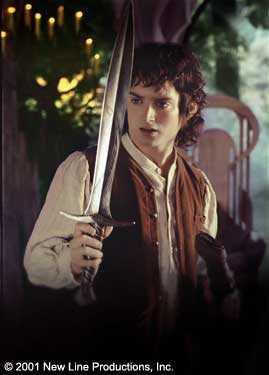 Is this a dagger I see before me – or is it a short-sword? Frodo (Elijah Wood) with Sting. |
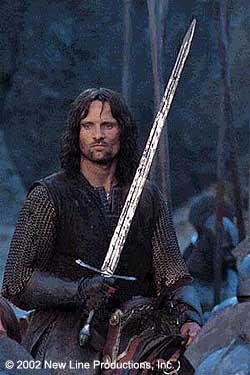 Aragorn (Viggo Mortensen) with his Ranger sword – not to be confused with Narsil/Andúril. |
B: Which one was the most challenging to make?
P: That's a tough one, because each has it own strengths and challenges. Glamdring, with its curved leaf blade, and blending into the cross and hilt, was different from the swords I had been used to making and was very satisfying to make, likewise Andúril/Narsil, which had challenging grinds on the hilt plus etching. The most challenging was definitely Gil-Galad's spear, Aeglos, but ultimately the most satisfying to make. The blade is curved and recurved, halving in thickness towards the tip, and also blending into the socket; the lines of the curves on the blade had to work with each other towards the tip without wavering. There is etching all over the socket and along the blade, and to finish it off the vines along the socket are raised detail in bronze wire with the leaves recessed as etching. I was the one who suggested raising the vine detail, and it was quite a challenge to get all the elements working, but it was worth the effort, though you might have to wait for the DVD release to fully appreciate the weapons.
B: Yeah, too bad the viewer gets just a brief glimpse of Aeglos in the Prologue. It's hard enough to tell it's Gil-Galad! Good to know that a lot of care went into stuff that didn't even get enough screen-time, though.
B: John, which sword was the most challenging to design?
J: Every sword was a challenge.
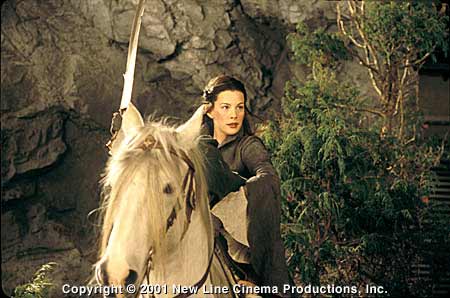
Arwen
(Liv Tyler) with her Elven sword.
B: How come the swords wielded by Arwen, Elrond and the other Elves are curved?
J: Why not? It fits well with their style of combat, and it's very Art Nouveau. Did Professor Tolkien say they are all straight? Damn, I must have missed that bit!
B: True; Tolkien wasn’t that specific about the look of the Elven weapons. When you say it, I can see that Art Noveau formed the overall basis for Elven design. Reminds me very much of Victor Horta, if I’m not totally off the mark.
J: Hector Guimard. The Elves are supposed to be far more sophisticated, beautiful and skilled than we can imagine as humans. There is an elegance of line in Art Nouveau that is unparalleled. Of course, Eastern weapons contributed quite a lot - imagine the Samurai with a totally 19th-century Jugendstil culture.
B: How did you two interact? With your sword-smithing skills and re-enactment experience, and John's experience of 15th century swords and swordsmanship, was the creative process boosted, resulting in swords that turned out different than first envisioned?
P: When I met John, all I knew at first was that he was one of the foremost Tolkien illustrators in the world; I only found out later that he is also part of one of the most prestigious recreationist groups in Europe. After a while we formed something of a mutual appreciation society, and I was really sorry when John had to return to Switzerland for his other commitments. Our jobs were fairly clear cut, with John designing and creating much of the overall look as well as specific items like weapons, and me making them. John's knowledge and experience made it much easier for me to construct the weapons, because he appreciates what it takes to make a sword "work" and the clarity of his artwork leaves nothing to chance. The design brief helped a lot too; the idea was to make weapons that didn't look just like historical counterparts, yet had to be weapons that would work properly. Since almost anything that works as a weapon has been used somewhere in history, this tended to pull the basic designs back towards historical models but without simply copying them. We both appreciate good weapons, so it made both our jobs easier.
J: Peter Lyon is a master armourer and sword smith. Production was VERY lucky to have him running the armoury at Weta. Peter's right, we had a two-member mutual appreciation club! You can design your heart out, but only the man working in metal can take it the rest of the way, if the direction he basically senses from the initial designs. It could easily go the other way, which would have been heartbreaking.
B: How much did you rely on the descriptions in the books? Tolkien was rather vague, but there are several hints on the design and performance of the swords.
P: The swords are all based on Tolkien's descriptions, but these are usually so brief, and sometimes so vague when looked at critically (for example, "great-hilted") that it left the designs very open. It was more about fitting the designs to the characters, and making each one distinctive and recognisable, but this is really a question that John can answer better than me.
J: Very little, I think the other motto being : "Well, it doesn't say it WASN'T like that in the books..."
B: What methods did you use? Forging, stock removal, or a combination of the two? Were there any difficulties due to the design?
P: Mostly the blades were made by stock removal, with some forging for example curving the blades of Arwen's and Gil-Galad's weapons. The designs themselves didn't present any difficulties, though different features often had to interact with each other in quite subtle ways, so I was often working on all the components of a sword at once to get the blend looking just right.
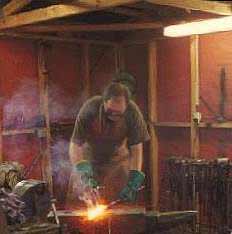
Peter
Lyon at work in his smithy.
B: Were the hilt parts cast or forged? Which materials were used for the grips?
P: The hilt parts were mostly steel, which would be forged and ground from solid blocks of steel. Some were of bronze, which were lost-wax cast from an original made by one of the sculptors at Weta. Mostly the grips were made on a wooden core, burnt onto the tang; they were generally finished with leather, but had wires or collars to add shape and interest.
B: How many swords did you make personally?
P: I haven't made an exact count, but it would be over 100 hero weapons, and 300-400 aluminium blades for the stunt swords.
B: That's quite a lot! I mean, a sword movie like "Highlander" used just half a dozen swords.
B: With your experience from re-enactment/living history, how do you think the fighting rates as compared to other movies? Fight director Bob Anderson is a veteran in the movie industry; did he have any influence on the design of the weapons?
P: The combat is as good as any I have seen in film. As well as the fight styles of the principle characters, a lot of work went into distinctive racial combat styles for the elves, humans, orcs, etc. [Developed by Tony Wolf.] This will become more apparent through the later films as more combat is seen. When Bob Anderson arrived, most of the weapons had be designed and were under construction. Bob is one of the legends of the film industry, with a career spanning 35 years, and he helped a lot with the fight styles of the main characters, and trained the stunt fighters and actors. He ended up by paying us the ultimate compliment on the durability of the stunt swords, saying he had to come to New Zealand to find a stunt sword that didn't break! That's a common problem in high-energy productions.
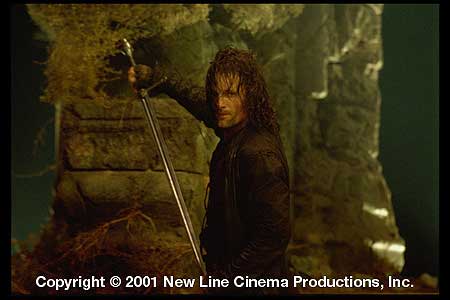
Aragorn (Viggo Mortensen) at Weathertop.
B: When the first pictures of the United Cutlery reproductions (Glamdring, Sting, Witch-king's sword) appeared, they were met with strong approval from the sword aficionados on the discussion board on Sword Forum International, even the more conservative of them. While the swords were designed and made for the movie first and foremost, did you expect the swords to become hailed as "the best fantasy swords ever seen" by some enthusiastic reviewers?
P: The good reception the swords have had, is as much a compliment to the talented design team here at Weta as it is to me. They deliberately avoided the spiky, heavy swords seen on so many walls; this actually required a greater concentration and discipline to make the designs work well. All along the idea was to design distinctive weapons that would still work as killing tools; in this sense the "best fantasy swords" title is a bit ironic, as we saw this film more as "created history" than fantasy.
J: Maybe they'll send me one free, do you think, if I ask?
B: Given that the swords appear to sell like hot cakes, they should!
|
|
 |
 |
 |
|
From top to bottom: Glamdring, Narsil, the sword of
the Witch King |
B: Do you think your work will have any influence on how fantasy swords will look? We're used to the horrible Spanish wall-hangers, with leering demon faces, skulls, spikes, serrated edges and other silliness; do you think we will see more toned-down, tasteful designs?
P: I hope so; the outrageous weapons that grace so many walls are a travesty of everything a sword should be. They are heavy and slow; in combat you would be killed before completing your attack. The design features on them can be as much danger to the users as their opponents. I hope that the Lord of the Rings films will show that fantasy weapons don't need to be outrageously overbuilt, but can be elegant as well.
J: No, bad taste rules on living room walls - in many more areas that swords. There is a lot of room on living room walls for tackiness. I don't care too much for the plaques they are suspended from, but it's a wee gripe...
B: Are there any other fantasy movie swords that you've found pleasing?
J: I liked Dracula's sword in the Coppola movie.
B: Hmm…That sword was based on a historical original, so perhaps the fantasy movie sword situation has been rather bleak up till now. Which are your criteria for a good sword?
P: The first thing I look for is whether it is a functional weapon, one that you would trust your life to in a life-or-death situation. This means the right length, weight and balance for the way you need to use it, a well tempered blade that doesn't wobble, no design features that impair its main function as a killing tool. This doesn't mean it has to be plain, as the swords from Lord of the Rings have shown.
J: It has to feel right. I know that's vague, but it encompasses every aspect of it, practically down to smell and taste. There is no one rule. Cinema has a terrible tendency to underline - to make sure things can be seen, whereas most weaponry is understated and simply rather not flashy enough for movie-goers' tastes.
B: If you had to pick a single historical sword, which one would it be?
J: I'd like one of each, please.
P: I like, and use, a straight bladed hand and half sword. I like because it is versatile, giving the choice of a strong two handed attack and defence, or removing one hand to displace an attack or grapple, or hold a shield. My second choice would be a large two hander because I have the stature and weight to use it effectively - I am 190cm and 98kg.
B: What is your impression of the renaissance of sword making and historical sword fighting? Are we experiencing a second lease of life for a weapon that was about to become a parade ground item or gaudy decorative object?
P: As an item of academic and sporting study the European sword is entering a second Renaissance, but we have to accept it is redundant as a battlefield weapon. I approach combat as a martial sport and a chance to understand something of our heritage. It is encouraging to see period combat regaining respectability, no longer used as a way to contrast and enhance the prestige of Eastern martial arts but as a martial art deserving respect in its own right. The study of the sword itself is showing it as a refined tool, especially the early pattern welded swords, rather than a crudely sharpened iron bar.
J: I doubt it. The wheel gets re-invented every day and it's still round. Most repro swords are pretty poor. Either it's a sharp and it never leaves your scabbard, or it's a blunt fighting sword, so it's already wrong. Bad taste has a bright future.
B: Is there anything you would like to say to sword fans out there?
P: Keep demanding quality and you will get it, and play a part in recreating and preserving the skills needed to make high quality swords. As long as you keep in mind what swords were, and are, truly about you will enhance our understanding and appreciation of them.
J: Yes, and plug your ears every time you hear that annoying and ludicrous "shwingggg!!!" noise of a sword coming out of a scabbard.
B: That sums it up rather nicely! I’m looking forward to the next movie, and not just for the swords. Thank you for your time, gentlemen.
John Howe and Peter Lyon
New Line Cinema
Blades by Brown Cutlery
“The Lord of the Rings” official movie website http://www.lordoftherings.net/index_flat.html
Weta Workshop http://www.wetafx.co.nz/workshop/index2.html
Lyonesse Armory http://www.swords.co.nz/
Blades by Brown Cutlery http://www.bladesbybrown.com/lotr.html
Please note that while Peter Lyon is happy to accept commissions for swords, he won’t make replicas of the swords in the movies. Swords inspired by the movies are OK, though.
© 2002 Björn Hellqvist
Images © New Line Cinema, Blades by Brown Cutlery, Peter Lyon, Philippe Krauer.